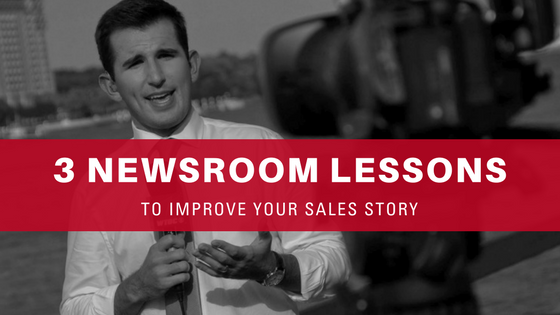3 newsroom lessons to improve your sales story
Humans are natural storytellers and we gravitate to stories — whether around a campfire, the office water cooler or on Netflix. The world of sales is no different.
A compelling narrative can be the difference between a pitch that converts prospects into clients and one that falls flat. That’s why sales stories are so important. (If you’re wondering what a sales story is, now would be a good time to catch up on my previous blog post about them.)
It’s time to start thinking of your sales presentation as content, not just a mindless pitch.
What newsrooms and boardrooms have in common
I spent several years working as an anchor and reporter for radio and television stations. While one meets a lot of people and sees a lot of things working in news, you may be thinking: “What could this former journalist possibly have to say about sales tactics?”
Well, to quote one of the most overused lines in film history: “We’re not so different, you and I.”
As a reporter, I encountered a number of people who were passionate about a variety of causes that I covered. Channeling that passion into a compelling narrative was part of the job, and it’s part of your job when presenting your sales story as well.
Ultimately, a journalist and a sales person have similar goals: to boil down a lot of important information into a presentation that’s understandable and that moves the audience to action.
So when it comes to crafting a winning sales story, it’s worth taking a page or two out of a reporter’s script. Here are a few lessons I learned from the newsroom that translate to creating an engaging sales story.
1. Ask yourself “so what?”
Producers and editors would always ask me this question when I would pitch story ideas or when they were editing my scripts. Pretty soon it became a knee-jerk reaction, and I would ask myself “so what?” when developing story ideas or writing stories.
The central question behind it is: “Why does the viewer care about this?” You may think the subject matter is important, but if you don’t make the story relatable to your audience and give them a reason to care about it, they’re just going to change the channel or tune you out.
The same principle applies to analyzing your sales story and the way you pitch prospective clients. Go review your pitch, and every time you make a claim, ask yourself, “So what?” This is an easy way to identify self-focused statements in your sales story.
People don’t care how great your company, product or service is — they care about solving their problems. Continually asking yourself “so what?” forces you into a more buyer-focused perspective.
2. Write for the ear
News writing come in many forms and styles. One of the big differences between writing for a newspaper, magazine or blog and writing for television, radio or a podcast is writing for the ear vs. writing for the eye.
Readers are much more focused than listeners, and they can always go back and reread something they don’t understand. When it comes to television and audio storytelling, you usually get one shot to get your message across. Viewers can’t or won’t rewind, plus they’re usually multitasking at the same time, too.
When crafting your sales story, write for your prospects’ ears. They’re distracted and likely skeptical about your pitch — so don’t blow your chance.
Your writing shouldn’t be rigid and generic. Should you be consistent? Yes. Is your sales story a one-size-fits-all solution? No. Think about who your audience is and find ways to tweak your foundational sales story for each opportunity to make it personal and memorable.
You may have visual aids like a sales deck or handouts, but never forget you are the one telling the story.
What ends up on camera impacts a story just as much as what you choose to leave out of the picture. Frame your sales story for the right audience when you write for the ear.
3. Aim for the heart
One of my favorite books from my journalism school days is “Aim for the Heart” by Al Tompkins. The foundation of the book is this: Good journalism is telling meaningful, people-focused stories that inspire and connect with audiences at an emotional level.
What does that mean for your sales story? Prospective clients won’t always remember what you tell them, but they will remember how you made them feel.
For example, you can present infographics, data points and past research on bionic eyes to make a point about your research hospital’s technology. Don’t get me wrong: These are good, valid tools. But if you show a video of an elderly man seeing his wife for the first time in a decade thanks to that technology, that is something your audience won’t soon forget.
Not every situation will be as dramatic as the example above, but consider how you can support your facts and data with a compelling narrative. A lasting impression can make your sales story stand apart from the rest.
I’d love to hear about your sales story success or challenges. I also enjoy commiserating over newsroom war stories. Either way, feel free to hit me up on Twitter.








